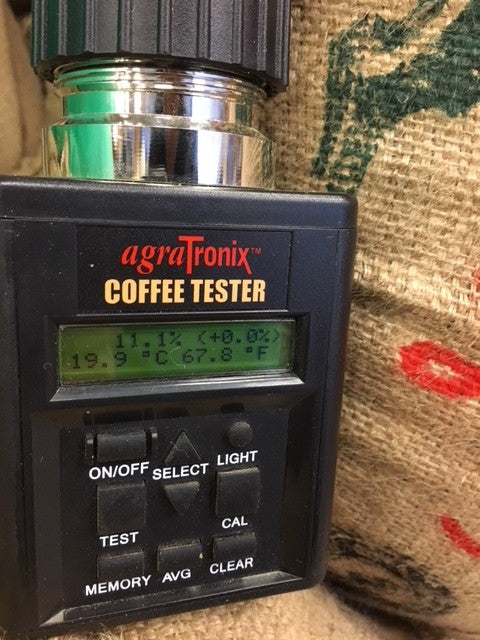Part of the preparation of unroasted coffee by the farmer or processing mill is to slowly dry it until it reaches an optimum moisture content of 9% to 12% This range is important, as coffee that is drier than 9% loses aroma and flavor, in part because it roasts much more quickly and is harder to control. Coffee that is wetter than 12% is susceptible to growing mold, which permanently taints the flavor.
We always test samples and new arrival coffees for moisture content, because not only does it tell you about the quality of the coffee, it also gives a hint as to how much heat it will require to roast it. As a general rule, we see natural processed coffees average a lower moisture content than washed process coffees. That is one of the reasons natural processed beans require less heat to follow a roasting profile. The moisture reading also hints at how much weight loss you will have when roasting. A high moisture coffee will have a greater loss in weight than a lower moisture coffee.
But the sweet spot really seems to be 10.5% to 11.5%. They roast the nicest, look the nicest, and tend to have the greatest complexity and aroma.
Once the coffee has been packed in grainpro bags and exported, the moisture content remains fairly stable. However an extremely dry storage or humid storage condition over time will effect the moisture content of the beans. Coffee warehouses and coffee roasters have to store their unroasted coffee in climate-controlled rooms to control humidity level and spot check levels of beans in storage to watch for changes.
We have seen some extreme readings. The India Monsooned Malabar bean registers at 7%, and it looks, feels, sounds, and roasts different than any other coffee we've ever seen. Coffee that we age in a whiskey barrel for a few days can come out with a moisture reading of almost 20%, causing the beans to require an immense amount of heat during the roast.




1 comment
Muchas gracias. ?Como puedo iniciar sesion?